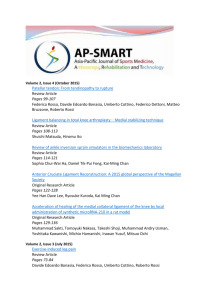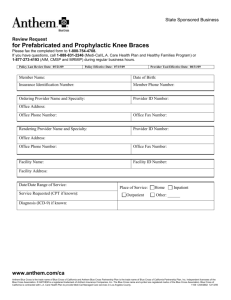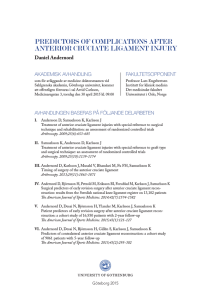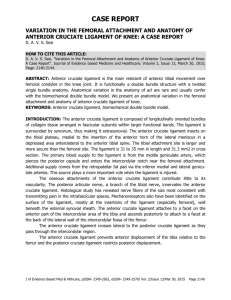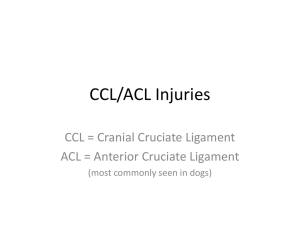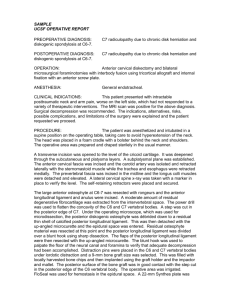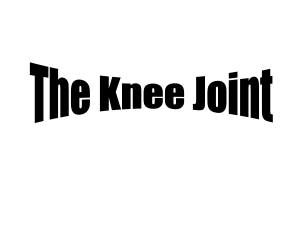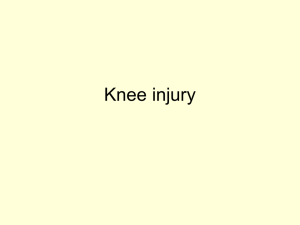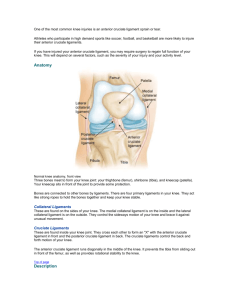anterior cruciate ligament,biomechanical double bundle model.
advertisement
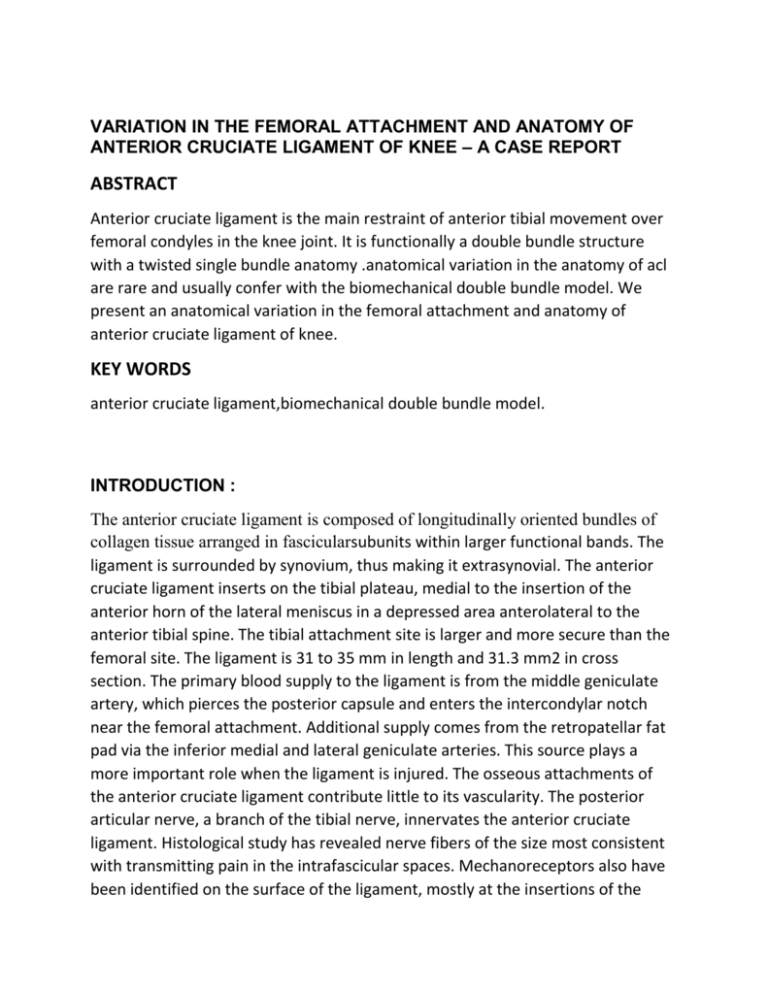
VARIATION IN THE FEMORAL ATTACHMENT AND ANATOMY OF ANTERIOR CRUCIATE LIGAMENT OF KNEE – A CASE REPORT ABSTRACT Anterior cruciate ligament is the main restraint of anterior tibial movement over femoral condyles in the knee joint. It is functionally a double bundle structure with a twisted single bundle anatomy .anatomical variation in the anatomy of acl are rare and usually confer with the biomechanical double bundle model. We present an anatomical variation in the femoral attachment and anatomy of anterior cruciate ligament of knee. KEY WORDS anterior cruciate ligament,biomechanical double bundle model. INTRODUCTION : The anterior cruciate ligament is composed of longitudinally oriented bundles of collagen tissue arranged in fascicularsubunits within larger functional bands. The ligament is surrounded by synovium, thus making it extrasynovial. The anterior cruciate ligament inserts on the tibial plateau, medial to the insertion of the anterior horn of the lateral meniscus in a depressed area anterolateral to the anterior tibial spine. The tibial attachment site is larger and more secure than the femoral site. The ligament is 31 to 35 mm in length and 31.3 mm2 in cross section. The primary blood supply to the ligament is from the middle geniculate artery, which pierces the posterior capsule and enters the intercondylar notch near the femoral attachment. Additional supply comes from the retropatellar fat pad via the inferior medial and lateral geniculate arteries. This source plays a more important role when the ligament is injured. The osseous attachments of the anterior cruciate ligament contribute little to its vascularity. The posterior articular nerve, a branch of the tibial nerve, innervates the anterior cruciate ligament. Histological study has revealed nerve fibers of the size most consistent with transmitting pain in the intrafascicular spaces. Mechanoreceptors also have been identified on the surface of the ligament, mostly at the insertions of the ligament (especially femoral), well beneath the external synovial sheath.theanterior cruciate ligament attaches to a facet on the anterior part of the intercondylar area of the tibia and ascends posteriorly to attach to a facet at the back of the lateral wall of the intercondylar fossa of the femur. The anterior cruciate ligament crosses lateral to the posterior cruciate ligament as they pass through the intercondylar region. The anterior cruciate ligament prevents anterior displacement of the tibia relative to the femur and the posterior cruciate ligament restricts posterior displacement FIGURE 1 BIOMECHANICS The anterior cruciate ligament is the primary restraint to anterior tibial displacement, accounting for approximately 85% of the resistance to the anterior drawer test when the knee is at 90 degrees of flexion and neutral rotation. Selective sectioning of the anterior cruciate ligament has shown that the anteromedial band is tight in flexion, providing the primary restraint, whereas the posterolateral bulky portion of this ligament is tight in extension. The posterolateral bundle provides the principal resistance for hyperextension. Tension in the anterior cruciate ligament is least at 30 to 40 degrees of knee flexion. The anterior cruciate ligament also functions as a secondary restraint on tibial rotation and varus-valgus angulation at full extension. Numerous authors have shown that although both the tibial and femoral attachment sites are important, errors in the femoral site are more critical because of the proximity to the center of axis of knee motion. A femoral tunnel that is too anterior will result in lengthening of the intraarticular distance between tunnels with knee flexion. VARIATION Anomalous attachment of bundle of ACL into intercondylararea .Here in the department of anatomy Rangaraya medical college we found a variation in the femoral attachment of ACL as well as the single unit anatomy being split into two in the upper half of ACL. Normally the ACL is a single twisted bundle of anteromedial and posterolateral functional bundles. The specimen showed a complete split of the functional bundles at the level of half the length of the ACL and the anteromedial bundle was attached to the center of the intercondylar notch of Femur (fig 2) ,[4]. FIGURE-2 DISCUSSION; The practical implications of this anterior location are “capturing” of the knee and loss of flexion or stretching and perhaps clinical failure of the graft as flexion is achieved. Posterior placement of the femoral tunnel or placement of the graft over the top of the lateral femoral condyle produces a graft that is taut in extension but loosens with flexion[4]. This location produces an acceptable result, since the instability from an anterior cruciate ligament deficiency occurs near terminal extension. The clinical examination yields a negative Lachman test result and a 1+ posterior drawer. If this location is chosen, the surgeon must secure the graft with the knee in extension, because securing the posteriorly located graft with the knee in flexion may result in loss of extension. If an over-the-top position is chosen, the route may be deeply grooved to approximate the“isometric” femoral position. [2,3]The preferred location has been isometric placement of the graft that limits changes in graft length and tension during knee flexion and extension, which possibly may lead to overstretching or failure of the graft[3]. Now, however, the concept of isometry is considered oversimplified, because basic science studies have shown that the normal anterior cruciate ligament is not isometric. The fiber bundles of the anterior cruciate ligament are under variable stress during knee motion[2]. The anteromedial bundle undergoes higher stress during flexion, and the posterolateral bundle undergoes higher stress during extension. Robotic technology has been used to study the in situ force in the anterior cruciate ligament in response to an anterior tibial load. The posterolateral bundle shows a trend similar to the intact anterior cruciate ligament, in which the in situ force in the anteromedial bundle remains relatively unchanged throughout the range of knee motion..After more than 25 years of experience with reconstruction of the anterior cruciate ligament, controversy remains over the location of both the tibial and femoral graft attachment sites[6]. Some surgeons advocate placing the tibial tunnel in a more anatomical site in the center of the tibial attachment site, accepting the fact that it is not isometric. Currently, most surgeons advocate placement of the graft at the posterior portion of the anterior cruciate ligament tibial insertion site near the posterolateral bundle position for best reproductionof the function of the intact anterior cruciate ligament[5]. This location also decreases graft impingement against the roof of the intercondylar notch with knee extension that can occur with anterior placement. CONCLUSION The finding of the variation described confers with the studied biomechanics extensively . The variation clearly reflects the physiological double bundle behavior of the ACL[2,4]. The anatomical double bundle reconstruction of the ACL when compared to single bundle reconstruction is far superior and coinciding with the variation found . The knowledge of these variation will give reasonable idea in planning for arthroscopic reconstruction of ACL injuries for Arthroscopic surgeons. It gives a guideline for prospective studies in the development of osteoarthritis of knee joint due to ACL injuries as well as anatomical variations in the attachment of ACL [1]. REFERENCES 1. Anterior Cruciate Ligament Insertions on the Tibia and Femur and Their Relationships to Critical Bony Landmarks Using High-Resolution VolumeRendering Computed Tomography Mark L. Purnell, MD†,*, Andrew I. Larson, BSME‡, and William Clancy, MD§ The American journal of sports …, 2008 - ajs.sagepub.com 2 Morphology of Anterior Cruciate Ligament Attachments for Anatomic Reconstruction: A Cadaveric Dissection and Radiographic Study Philippe Colombet, M.D.a, , , James Robinson, M.S., F.R.C.S.(Orth.)a, Pascal Christel, M.D.b, Jean-Pierre Franceschi, M.D.c, Patrick Djian, M.D.b, d, Guy Bellier, M.D.d, Arthroscopy: The Journal of Arthroscopic & Related Surgery Volume 22, Issue 9, September 2006, Pages 984–99 3. Tunnel Positioning of Anteromedial and Posterolateral Bundles in Anatomic Anterior Cruciate Ligament ReconstructionAnatomic and Radiographic Findings ThoreZantop, MD†,*, Mathias Wellmann, MD†, Freddie H. Fu, MD‡, and Wolf Petersen, MD†Am J Sports Med January 2008 36 65-72; published online before printOctober 11, 2007, 4.Femoral Insertions of the Anteromedial and Posterolateral Bundles of the Anterior Cruciate Ligament: Morphometry and Arthroscopic Orientation Models for Double-Bundle Bone Tunnel Placement—A Cadaver StudyRainerSiebold, M.D.a, , , Thomas Ellert, M.D.a, Stefan Metz, M.D.b, Jürgen Metz, M.D.c The Journal of Arthroscopic & Related SurgeryVolume 24, Issue 5, May 2008, Pages 585–592 5. Cadaveric Knee Observation Study for Describing Anatomic Femoral Tunnel Placement for Two-Bundle Anterior Cruciate Ligament ReconstructionTomoyuki Mochizuki, M.D., Ph.D.a, Takeshi Muneta, M.D., Ph.D.a, , , Tsuyoshi Nagase, M.D.a,Shin-ichiShirasawa, M.D., Ph.D.a, Kei-ich Akita, M.D., Ph.D.b, Ichiro Sekiya, M.D., Ph.D.Arthroscopy: The Journal of Arthroscopic & Related SurgeryVolume 22, Issue 4, April 2006, Pages 356–361 6.The attachments of the anteromedial and posterolateral fibre bundles of the anterior cruciate ligament. Femoral attachment Andrew Edwards1 , Anthony M. J. Bull2 and Andrew A. Amis3 Department of Mechanical Engineering, Imperial College London, London, SW7 2AZ, UK andrewed@doctors.org.uk Bioengineering Department, Imperial College London, a.bull@imperial.ac.uk Departments of Mechanical Engineering and Musculoskeletal Surgery, Imperial College London a.


